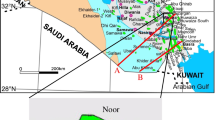Abstract
Saturated biomarker source and maturity parameters obtained from Gas chromatography-mass spectrometry were analyzed using multivariate statistical methods to maximize diagnostic information on the hopanes and sterane spectrum. This statistical method provided the identification of structural relationships (similarities and differences) between various fingerprint descriptors for the crude oil samples. The results emphasized the separation of the oil samples in regards to their locations into two genetic families. This separation pattern is more evident when principal component analysis was applied to biomarker data compared with the standard biomarker cross-plots. Such compositional differences are commonly attributed to unique source rock paleodepositional environments. The plotted source and maturity diagnostic parameter in a dendrogram separated the oils into two families both having terrestrial input. The group that have higher terrestrial input contain more oleananes, and have the highest Pr/Ph ratio. They are generated from source rocks with a high abundance of terrestrial organic matter. The second groups of oils have mixes of terrestrial and marine organic matter with lesser amount of oleananes.
Similar content being viewed by others
References
Cheng, K., Xiong, Y., and Zeng, X., 2002, Research on coal-derived hydrocarbon in Turpan-Hami Basin. Acta Petroleum Sinica, 23, 13–17.
Ekweozor, C.M. and Daukoru, E.M., 1994, Northern Delta depobelt of the Akata — Agbada (1) petroleum system, Niger Delta, Nigeria. In: Magoon, L.B. and Dow, W.G. (eds.), The Petroleum System from source to trap. American Association of Petroleum Geologist memoir, 60, 599–613.
Eneogwe, C. and Ekundayo, O., 2003, Geochemical correlation of crude oils in the NW Niger Delta, Nigeria. Journal of Petroleum Geology, 26, 95–103.
Halpern, H.I., 1995, Development and applications of light hydrocarbon-based star diagrams. American Association of Petroleum Geologists Bulletin, 79, 801–815.
Hunt, J.M., 1996, Petroleum Geochemistry and Geology. 2nd edition, Freeman, New York, 743 p.
Irwin, H. and Meyer, T., 1990, Lacustrine organic facies. A biomarker study using multivariate statistical analysis. Organic Geochemistry, 16, 176–120.
Isaksen, G.H., 1991, Molecular geochemistry assists exploration. Oil & Gas Journal, 18, 127–131.
Klett, T.R., Ahlbrandt, T.S., Schmoker, J.W., and Dolton, J.L., 1997, Ranking of the world’s oil and gas provinces by known petroleum volumes. US Geological survey open-file report, 97–463.
Kulke, H., 1995, Nigeria. In: Kulke, H., (ed.), Regional Petroleum Geology of the World, Part II, Africa, America, Australia and Antarctica. Berlin, Gebruder Borntraeger, 143–172.
Mackenzie, A.S., 1984, Application of biological markers in petroleum geochemistry. In: Brooks, J. and Welte, D.H. (eds.), Advances in Petroleum Geochemistry. Academic Press, London, 115–214.
Mango, F.C., 1994, The origin of light hydrocarbons in petroleum: ring preference in the closure of carboxylic rings. Geochimica et Cosmochimica Acta, 58, 895–901.
Michele, L.W.T., Michael, E.B., and Charpentier, R.R., 2010, The Niger Delta petroleum system: Niger Delta province, Nigeria, Cameroon and Equatorial Guinea, Africa. Open-file report 99- 50-H, U.S. Department of the interior, U.S. Geological Survey, 1–15.
Odden, W. and Kvalheim, O.M., 2000, Application of multivariate modeling to detect hydrocarbon components for optimal discrimination between two source rock types. Applied Geochemistry, 15, 611–627.
Onojake. M.C., Ukerun, S.O., and Iwuoha, G., 2011, A Statistical Approach for Evaluation of the Effects of Industrial and Municipal Wastes on Warri Rivers, Niger Delta, Nigeria. Water Quality Exposure Health, 3, 91–99.
Pasadakis, N., 2004, Determination of the continuity in oil reservoirs using principal component analysis of biomarker data. Petroleum Science and Technology, 20, 1087–1096.
Peters, K.E., Moldowan, J.M., Schoell, M., and Hempkins, W.B., 1986, Petroleum isotopic and biomarker composition related to source rock organic matter and depositional environment. Organic Geochemistry, 10, 17–27.
Peters, K.E., Watters, C.C., and Moldowen, J.W., 2005, The Biomarker Guide. Cambridge University press, Cambridge, 1155 p.
Pradhan, U.K., Shirodkar, P.V., and Shahu, B.K., 2009, Physicochemical characteristic of the coastal water off Devi estuary, Orissa and evaluation of its seasonal changes using chemometric techniques. Current Science, 96, 1203–1209.
Praus, P., 2005, Water quality assessment using SVD-based principal component analysis of hydrological data. Water SA, 31, 417–422.
Reemtsma, T. and Ittekott, V., 1992, Determination of factors controlling the fatty acid composition of setting particles in the water column by principal-component analysis and their quantitative assessment by multiple regression. Organic Geochemistry, 18, 121–129.
Stojanoviæ, K., Jovanèiæeviæ, B., Vitoroviæ, D., Golovko, Y., Pevneva, G. and Golovko, A., 2007, Evaluation of saturated and aromatic hydrocarbons oil-oil maturity correlation parameters (SE Pannonian Basin, Serbia). Journal of Serbian Chemical Society, 72, 1237–1254.
Sundararaman, C., Nicholas, J., and Diedjomahor, J.O., 2002, Niger Delta Petroleum System: Regional Geology, organic facies and Thermal Maturity. American Association of Petroleum Geologist annual meeting, March 10–13, Houston Texas, 1–13.
Volk, H., George, C.S., Middleton, H., and Schofield, S., 2006, Geochemical comparison of fluid inclusion and present-day oil accumulations in the Papuan Foreland — evidence for previously unrecognized petroleum source rocks. Organic Geochemistry, 36, 29–51.
Xiong, Y, Cheng, K., and Yang, Z., 2004, Advances in the correlation of oils and source in the Jiuxi depression, Northwest China. Petroleum Exploration & Development, 31, 36–39.
Zumberge, H.E., 1987, Prediction of source rock characteristics based on terpane biomarkers in crude oils: a multivariate statistical approach. Geochimica et Cosmochimica Acta, 51, 1625–1637.
Author information
Authors and Affiliations
Corresponding author
Rights and permissions
About this article
Cite this article
Osuji, L.C., Oforka, N.C. & Onojake, M.C. Multivariate analysis of source and maturity biomarker indices of crude oils from SW Niger Delta. Geosci J 18, 365–371 (2014). https://doi.org/10.1007/s12303-014-0001-2
Received:
Accepted:
Published:
Issue Date:
DOI: https://doi.org/10.1007/s12303-014-0001-2




